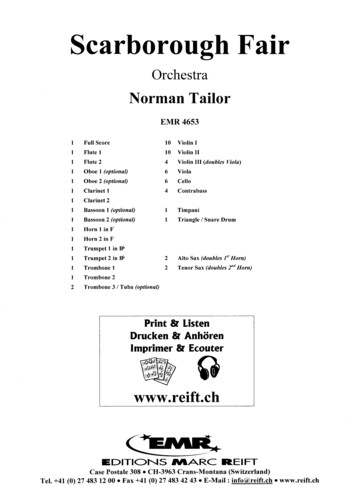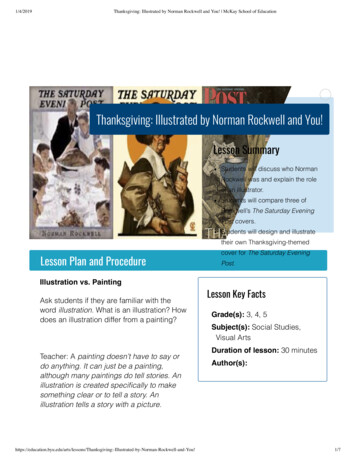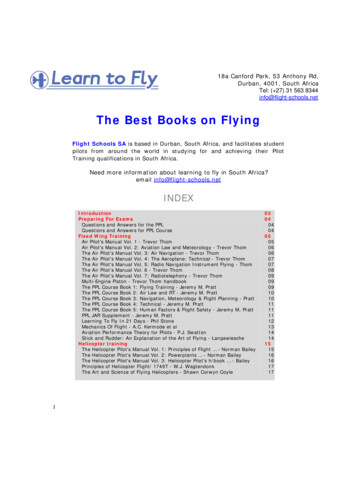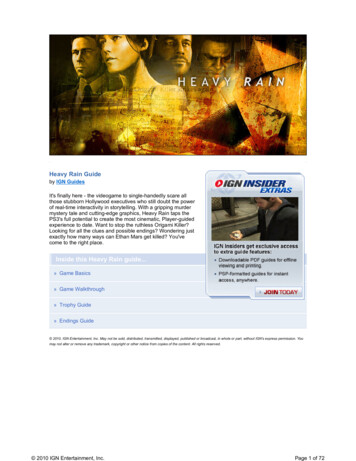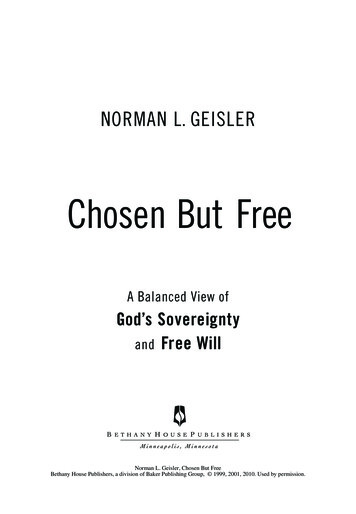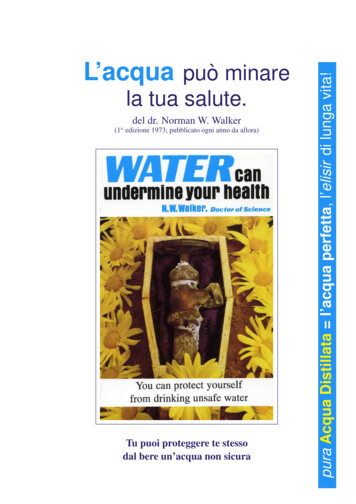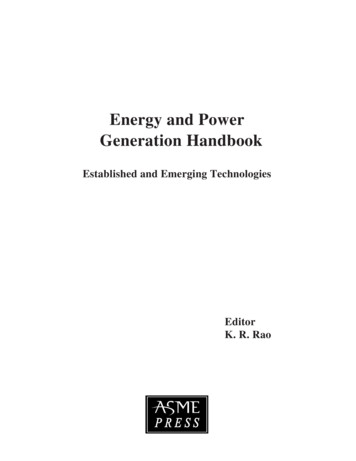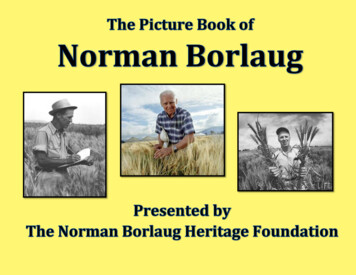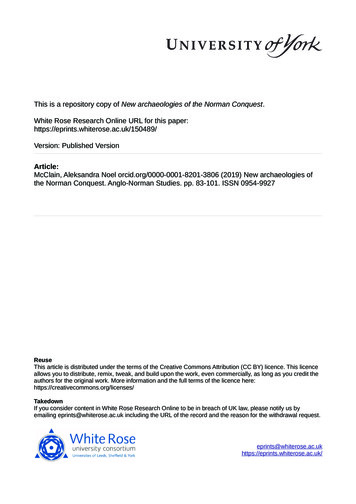
Transcription
This is a repository copy of New archaeologies of the Norman Conquest.White Rose Research Online URL for this on: Published VersionArticle:McClain, Aleksandra Noel orcid.org/0000-0001-8201-3806 (2019) New archaeologies ofthe Norman Conquest. Anglo-Norman Studies. pp. 83-101. ISSN 0954-9927ReuseThis article is distributed under the terms of the Creative Commons Attribution (CC BY) licence. This licenceallows you to distribute, remix, tweak, and build upon the work, even commercially, as long as you credit theauthors for the original work. More information and the full terms of the licence If you consider content in White Rose Research Online to be in breach of UK law, please notify us byemailing eprints@whiterose.ac.uk including the URL of the record and the reason for the withdrawal terose.ac.uk/
This chapter is available as Open Access under the CC-BC licenceNEW ARCHAEOLOGIES OF THE NORMAN CONQUESTAleksandra McClain and Naomi SykesIt is becoming clear that the Norman Conquest both initiated and intensified farreaching changes at all levels of society, including culture and identity, socialstructure, economy, diet, art and architecture, portable material culture, rural andurban settlement, manorial and community landscapes, religion and mortuary practice, and the management of the environment. Many of these elements are eitherinaccessible from documentary evidence alone or have distinct material implications, and recent archaeological research is beginning to show that they have thepotential to complicate traditional historical narratives of the Conquest, or take ourunderstanding of the period in new directions.1 Nevertheless, the vast majority ofacademic scholarship on the Conquest has been carried out without reference tothe abundant archaeological evidence from the eleventh and twelfth centuries thathas been recovered in excavation and still survives above ground. As a result, bothacademic and public understanding of the Conquest has been predicated primarilyon its impact on the elite social classes, and on narratives that have been derivedalmost entirely from the wealth of documentary history available for the period. Thecomprehensive archaeology of the Norman Conquest and Anglo-Norman transitionis therefore a story that is yet to be told.This paper articulates key themes, research directions, and a new case study emergingfrom the project ‘Archaeologies of the Norman Conquest’, an AHRC research networkled jointly by the authors.2 The chief objective of the project has been to create andsustain a research community linked by an interest in revitalizing archaeologicalresearch in the eleventh and twelfth centuries, in order to examine the cultural, social,and political implications of the Norman Conquest and its aftermath through an explicitfocus on material culture. The network has brought together the humanistic, scientific,academic, professional and public-engagement arms of archaeology, as well as keyparticipants from cognate disciplines, in a range of workshops focusing on themes ofinterpretative agendas, methodologies, international perspectives and public outreach.The central aim has been to create a materially focused research framework for theperiod which can be engaged with and taken forward by both archaeological and interdisciplinary audiences. This article is a first step in that direction.The network and its activities address a prominent gap in the current researchenvironment focusing on the eleventh and twelfth centuries. The Battle and Haskins1Naomi J. Sykes, The Norman Conquest: A Zooarchaeological Perspective, BAR International Series1656, Oxford 2007; Ben Jervis, ‘Conquest, Ceramics, Continuity and Change. Beyond RepresentationalApproaches to Continuity and Change in Early Medieval England: A Case Study from Anglo-NormanSouthampton’, Early Medieval Europe 21, 2013, 455–87; Michael Fradley, ‘Scars on the Townscape:Urban Castles in Saxo-Norman England’, in The Archaeology of the Eleventh Century: Continuitiesand Transformations, ed. Dawn M. Hadley and Christopher Dyer, Abingdon 2017, 120–38; AleksandraMcClain, ‘Rewriting the Narrative: Regional Dimensions of the Norman Conquest’, in The Archaeologyof the Eleventh Century, 203–27.2Project reference: AH/P006841/1; http://www.normanarchaeology.org
84Aleksandra McClain and Naomi Sykesconferences have made strides in recent years by including more work from thefields of archaeology and material culture, including the extremely welcome addition of an annual archaeology-focused memorial lecture at Battle (see Roffe, thisvolume). Nevertheless, archaeology and archaeologists have customarily beena featured extra instead of core members of these two most prominent events ofAnglo-Norman scholarship. The root causes of archaeology’s lack of engagementwith the eleventh and twelfth centuries and the Conquest itself will be discussed inmore detail below, but on the whole, the problem stems less from other disciplinesrefusing to listen to what archaeologists have to say than from archaeology doingtoo little to make itself heard. For a variety of reasons, archaeologists have not sufficiently appreciated that the period is not only brimming with unexplored potentialin and of itself, but can also inform much broader questions about the interactionsbetween society, material culture, ethnicity, culture contact and political transition that are enormously relevant to many other periods of human history. Whileinnovative archaeological scholarship on the Conquest is taking place, it has beencarried out by a relatively small number of scholars often isolated by methodologyor sector, without a like-minded community of material-culture specialists interestedin the period to listen, read, comment and spur on further research. The networkhas thus offered a space in which dialogue and collaboration between the range ofspecialisms within archaeology can be fostered, focusing specifically on what wecan do together to interrogate more fully how and why the Norman Conquest andAnglo-Norman transition happened, and the significance of the material dimensionsof that process.The Current State of Norman Conquest ArchaeologyThe supposed invisibility of the Norman Conquest in the material record, at leastwhen it comes to the ‘stuff of everyday life’ which is regarded as the primarypurview of archaeology, has posed a longstanding quandary for the discipline.3Trevor Rowley has written that archaeologists have always been ‘more conservative’in our attitudes to the impact of the Conquest than cognate historical disciplines,despite acknowledging that the spread of castles across the English landscape andthe mass rebuildings of churches in Romanesque styles after 1066 were undoubtedly significant, tangible signatures of the arrival of the Normans.4 He argued thatthis conservative perspective has stemmed primarily from the lack of immediate,obvious stylistic or technological changes in more prosaic material elements suchas pottery, tools, and craft materials like wood, metal, bone and leather, suggestingthat life for the masses went on much as before, despite the political upheaval.5Instead of facing this apparent contradiction head on, or seeing it as an opportunity to investigate a period of particular complexity, the response of the discipline was instead to avoid the subject, and leave most nuanced interrogation ofthe process and effects of the Conquest to documentary historians. Despite the factthat the Conquest is easily the most widely recognized event in the English MiddleAges, Rowley’s 1997 work Norman England: An Archaeological Perspective on theDavid Griffiths, ‘The Ending of Anglo-Saxon England: Identity, Allegiance, and Nationality’, inThe Oxford Handbook of Anglo-Saxon Archaeology, ed. David A. Hinton, Sally Crawford, and HelenaHamerow, Oxford 2011, 62–78 at 62–3.4Trevor Rowley, Norman England: An Archaeological Perspective, London 1997, 12.5Rowley, Norman England, 134; Trevor Rowley, Norman England (Shire Living Histories), London2010, 1.3
New Archaeologies of the Norman Conquest85Norman Conquest was the first general academic book on the Norman Conquest witha specific focus on archaeology.6 Remarkably, there were no further attempts in theintervening twenty years, until the arrival of Dawn Hadley and Christopher Dyer’s2017 edited volume The Archaeology of the Eleventh Century: Continuities andTransformations.7 This is in marked contrast to the many Norman Conquest overviews from a historical perspective which have been published relatively recently.8The lack of scholarship is emphatically not the result of a lack of archaeologicaldata. On the contrary, a wealth of buildings, material culture and landscape evidenceexists from the period, as well as human, animal and plant remains. However, thisdata is most often subsumed within wide-ranging considerations of a particular typeof material culture or evidence, emphasizing the developmental trajectories of aclass of settlement, landscape, building or artefact over the longue durée of thewhole of the medieval period, or the early or late Middle Ages – frustratingly,often ending at 1066 or beginning after it. Vital data pertinent to the period is alsocontained within large, multi-period excavations of rural sites, of which WharramPercy, Goltho and Faccombe Netherton are three of the best known, as well as majorurban excavations at such sites as Winchester, Lincoln, York and Wallingford.9There is of course considerable value in couching eleventh- and twelfth-centurymaterial within the context of longer and broader developmental trends, rather thanlooking at it in relative isolation. Nevertheless, consistently having taken the (very)long view means that we have lacked a body of research which specifically marshalsmaterial evidence to ask probing questions about how the Conquest happened, theways in which the material dimensions of this socio-cultural transition were important, or even about distinctive elements of the eleventh and twelfth centuries andthe role the period played in longer trajectories. The lack of a coherent intellectualframework has resulted in work which often undertakes the essential first step ofcharacterizing the material culture from the period, but stops short of analysing itssignificance in the context of wider research questions, preventing archaeologistsfrom playing a substantive role in scholarly debates on the Norman Conquest.Neither Rowley’s, nor Hadley and Dyer’s, book explicitly seeks to lay outresearch agendas for the archaeology of the Conquest, although some key themescan be discerned, as can the impact of broader theoretical and disciplinary developments within academic archaeology over the past two decades. Rowley focusesconsistently on the coexistence of continuity and change throughout the period,emphasizing continuity at ‘everyday’ levels and watershed-worthy change atelite levels, and he cites the arrival of a more systematic and consistently defined6Rowley, Norman England.The Archaeology of the Eleventh Century: Continuities and Transformations, ed. Dawn M. Hadleyand Christopher Dyer, Abingdon 2017.8Amongst others, Hugh M. Thomas, The Norman Conquest: England after William the Conqueror,Lanham 2008; George Garnett, The Norman Conquest: A Very Short Introduction, Oxford 2009; RichardHuscroft, The Norman Conquest: A New Introduction, Harlow 2009; Brian Golding, Conquest and Colonisation: The Normans in Britain, 1066–1100, Basingstoke 2013.9A History of Wharram Percy and its Neighbours, ed. Stuart Wrathmell, Wharram: A Study of Settlement on the Yorkshire Wolds XIII, York 2012; Guy Beresford, Goltho: The Development of an EarlyMedieval Manor, c. 850–1150, London 1987; J. R. Fairbrother, Faccombe Netherton: Excavations of aSaxon and Medieval Manor Complex, vols I and II, London 1990; Martin Biddle, Object and Economyin Medieval Winchester, vols I and II, Oxford 1990; Michael Jones, David Stocker, and Alan Vince,The City by the Pool: Assessing the Archaeology of the City of Lincoln, Oxford 2003; Patrick Ottawayand Nicola Rogers, Craft, Industry and Everyday Life: Finds from Medieval York, The Archaeology ofYork 17/15, York 2002; Neil Christie and Oliver Creighton, Transforming Townscapes: From Burgh toBorough, the Archaeology of Wallingford, Abingdon 2013.7
86Aleksandra McClain and Naomi Sykesfeudal social system as a major Norman contribution.10 His stress on the widespread evidence for continuity was likely more groundbreaking in archaeologicalcircles at the time than it seems to us twenty years on, although it should benoted that it still lagged somewhat behind the critical assessments of the variableimpact of the Normans conducted by some documentary scholars.11 Throughout thevolume, Rowley’s discussions focus primarily on the material evidence of castles,churches, and urban and rural planning. He cites the supposed ‘invisibility’ ofthe Conquest in other areas of archaeology, particularly small finds, and does notprobe it much further, conceding that material culture may be a less-than-idealmedium for tracking short-term or subtle change.12 Rowley also flirts with the ideathat cultural exchange around the Conquest was more complicated than is oftensupposed, and although he does not address the intricacies of the issue in full, justacknowledging the reflexive influence of conquered upon conquerors was an innovative theme, and one that still remains to be substantively explored in subsequentarchaeological scholarship.13Hadley and Dyer’s volume demonstrates that while archaeology has undoubtedlymoved on in the intervening decades, some concerns remain the same. The Archaeology of the Eleventh Century, like Rowley’s book, focuses heavily on the dualityof continuity and change in the period, as the subtitle communicates. The lack ofprecision in dating around 1066 is an issue that has still not been satisfactorilyresolved, nor is it likely to be when style is the primary diagnostic element, althoughadvances in the availability and precision of absolute dating such as radiocarbonhave been noted.14 However, on the whole it is clear that those twenty years havebrought archaeologists greater confidence in their ability to contribute to scholarlydialogue on the Conquest. In their introduction, Hadley and Dyer state outright thatarchaeology can provide insights to elements of the period which have no connection to political events, documentation or ‘great men’, and they offer no concessionto archaeological ‘invisibility’ in the period.15 The complete lack of any mentionof feudalism in the volume, even during considerations of castles, manors and thecountryside after 1066, stands in stark contrast to Rowley’s discussions, and demonstrates how much more comfortable modern medieval archaeology has become inmoving away from the parameters of traditional historical debates.When reviewing Norman England, Robert Higham wrote that of the amplearchaeological evidence for change that Rowley cited, ‘it would be interesting todistinguish those changes specifically arising from the “Normanness” of theConquest from those which flowed more generally from the economic, artistic,military and intellectual growth which the twelfth century witnessed on a wider10Rowley, Norman England, 21, 123, 134.Robin Fleming, Kings and Lords in Conquest England, Cambridge 1991; Ian Short, ‘“Tam Angliquam Franci”: Self-Definition in Anglo-Norman England’, ANS 18, 1995, 153–75; Hugh M. Thomas,‘The significance and Fate of the Native English Landholders of 1086’, English Historical Review118:476, 2003, 303–33.12 Rowley, Norman England, 13.13 Rowley, Norman England, 13, 32, 110.14 Dawn M. Hadley and Christopher Dyer, ‘Introduction’, in The Archaeology of the Eleventh Century:Continuities and Transformations, ed. Dawn M. Hadley and Christopher Dyer, Abingdon 2017, 1–13at 2. For commentary on radiocarbon dating, see Elizabeth Craig-Atkins, ‘Seeking “Norman Burials”:Evidence for Continuity and Change in Funerary Practice Following the Norman Conquest’, in TheArchaeology of the Eleventh Century, 139–58 at 155.15 Hadley and Dyer, ‘Introduction’, 2.11
New Archaeologies of the Norman Conquest87front’.16 It is heartening to see that Higham’s directive eventually became a centraltheme in The Archaeology of the Eleventh Century, which throughout stresses thestrength of archaeology to contribute to our understanding of the context of broadereleventh- and twelfth-century trajectories.17 However, a full understanding of thesedevelopments requires looking beyond England to a wider European context,both to Normandy and the other countries of the British Isles, obviously, but alsoto regions where 1066 was a footnote rather than a watershed. Both Rowley’sand Hadley and Dyer’s volumes acknowledge the importance of an internationalperspective, and offer some parallel history of what was happening on the Continent at the time, yet there are no chapters in the edited volume which considerevidence from outside England.18 Archaeological scholarship published in Englishwhich encompasses this period on the Continent is thin on the ground, and fewproductive connections or discussions have as yet been made with archaeologistswriting on the period in other countries – another situation which the networkproject has sought to improve.19The Value of Material Approaches to the Norman ConquestA significant part of archaeology’s lack of engagement with the Norman Conquesthas stemmed from our historically complicated relationship with documentedperiods of the past, which has been covered extensively in other work.20 This tensionis particularly pronounced in the eleventh and twelfth centuries, due to the explosion of documentation that resulted from the establishment of Norman bureaucracies, legal frameworks and religious institutions. This remarkable wealth of writtenevidence has of course fuelled the long tradition of historical work on the period,but it has also perhaps intimidated archaeologists into thinking there is little wecan add to the discussion, and that our efforts might be better spent where thedocumentary record is less comprehensive. Alongside the large body of textualscholarship that has been generated on the period, the apparent confluence betweenthe most obvious forms of ‘Norman’ material culture (e.g. castles, major churches)and a story of successful Norman imposition can also give the impression that the16Robert A. Higham, ‘Review of Trevor Rowley, Norman England: An Archaeological Perspective onthe Norman Conquest’, Archaeological Journal 155, 1998, 410–11 at 411.17 Hadley and Dyer, ‘Introduction’, 2. See also the case study below for commentary on longer-termprocesses.18 Rowley, Norman England, 13–19; Hadley and Dyer, ‘Introduction’, 6–7. Continental contexts andthe ‘European aristocratic diaspora’ are also touched on in Keith D. Lilley, ‘Urban Landscapes and theCultural Politics of Territorial Control in Anglo-Norman England’, Landscape Research 24:1, 1999,5–23 at 18.19 Two examples published in English are David Petts, ‘Churches and Lordship in Western NormandyAD 800–1200’, in Churches and Social Power in Early Medieval Europe: Integrating Archaeologicaland Historical Approaches, ed. Jose C. Sanchez-Pardo and Michael Shapland, Turnhout 2015, 297–338and Elisabeth Zadora-Rio, ‘The Making of Churchyards and Parish Territories in the Early-MedievalLandscape of France and England in the 7th-12th Centuries: A Reconsideration’, Medieval Archaeology47, 2003, 1–19.20 The best-known discussion is still found in David Austin, ‘The “Proper Study” of Medieval Archaeology’, in From the Baltic to the Black Sea: Studies in Medieval Archaeology, ed. David Austin andLeslie Alcock, London 1990, 9–42. For two more recent perspectives, see also Martin O. H. Carver,‘Marriages of True Minds: Archaeology with Texts’, in Archaeology: The Widening Debate, ed. BarryCunliffe, Wendy Davies and A. Colin Renfrew, Oxford 2002, 465–96 and the chapter ‘Archaeology andits Discontents’ in Guy Halsall, Cemeteries and Society in Merovingian Gaul: Selected Studies in Historyand Archaeology, 1992–2009, Leiden 2010.
88Aleksandra McClain and Naomi Sykesperiod is both straightforward and already well understood. Until very recently, theConquest seemed to incite in us what Richard Bradley has called archaeology’s ‘lossof nerve’ – the silence that results when we fear we cannot say anything valuableabout the past, or in this case, anything that history has not already said.21In general, historians have been considerably better at parsing the impact of theConquest and critiquing the ‘story’ told by the documentary evidence than havethose who deal with material culture. Particular patterns or lacunae in late eleventh- or early twelfth-century material evidence have been explained by attributingthem to the simple existence of the Norman Conquest or some feature of it, suchas the Harrying of the North, without further interrogation.22 A lack of thoroughengagement with the relevant historical scholarship on the period has resulted inarchaeologists at times framing our interpretations around grand narratives whichhave already been critiqued, questioned, or deconstructed by historians – a problemwhich Guy Halsall has noted in other historical periods as well.23 While archaeologyshould not be subordinated to history’s research questions any more than historyshould be subordinated to ours, the solution is not for archaeology to avoid engagingwith historical agendas and evidence, as David Austin once argued.24 In the eleventh and twelfth centuries, it is actually becoming clear that archaeology’s agendasincreasingly align with or complement those of historians, especially as economic,social and cultural histories have come to the fore alongside the traditional subjectsof legal, military and political history, and, most significantly, with the advent of thematerial turn in history and other humanities.25 Best practice will allow these areasof confluence to be identified and developed in collaboration with each other, whilestill leaving each discipline free to explore research questions and avenues whichare more particular or disciplinarily specific.As an antidote to archaeology’s sometime intimidation in the face of highly documented periods, Halsall has argued instead that the more extensive the written recordin a period, the greater the potential of archaeology to complement that record, butalso to question and challenge it, in order to provide better insight into social andideological structures. A much richer understanding is possible in periods where thematerial and documentary records are both substantial, rather than when one or theother dominates.26 In raw material terms, therefore, the untapped collaborative andinterdisciplinary potential of the eleventh and twelfth centuries is clear. However,the volume of documentary evidence, or scholarship, is in some sense irrelevant tothe value of material culture to this period. Material culture has much to add to thestudy of the Norman Conquest, or indeed any period of transition, not only because21Richard Bradley, ‘Archaeology: The Loss of Nerve’, in Archaeological Theory: Who Sets theAgenda?, ed. Norman Yoffee and Andrew Sherratt, Cambridge 1993, 131–3 at 133.22 Pamela Allerston, ‘English Village Development: Findings from the Pickering District of North Yorkshire’ Transactions of the Institute of British Geographers 51, 1970, at 106; Christopher Harper-Bill, ‘TheAnglo-Norman Church’, in A Companion to the Anglo-Norman World, ed. Christopher Harper-Bill andElisabeth van Houts, Woodbridge 2002, 165–90 at 171; Nigel Saul, English Church Monuments in theMiddle Ages, Oxford 2009, 24.23 Halsall, ‘Archaeology and its Discontents’, 76.24 Halsall, ‘Archaeology and its Discontents’, 87; Austin, ‘The “Proper Study”’, 12–13.25 Hugh M. Thomas, ‘History, Archaeology and the Norman Conquest’, in The Archaeology of theEleventh Century, 283–300 at 283; History and Material Culture: A Student’s Guide to ApproachingAlternative Sources, ed. Karen Harvey, Abingdon 2009; Dan Hicks and Mary C. Beaudry, ‘Introduction.Material Culture Studies: A Reactionary View’ in The Oxford Handbook of Material Culture Studies, ed.Dan Hicks and Mary C. Beaudry, Oxford 2010, 1–21 at 1.26 Halsall, ‘Archaeology and its Discontents’, 84.
New Archaeologies of the Norman Conquest89it is valuable to us now, as some of the best surviving evidence of past social behaviour, but also because it was enormously important to people at the time.Humans are uniquely material animals, set apart by our creation of artefacts,art, technology and an extensive built environment and anthropogenic landscape.Indeed, ‘material culture’ itself may be a redundant term, as it is not really possibleto define a form of human culture which is not materially enacted in some way.27In periods of social pressure or intense change – for which the Norman Conquestundoubtedly qualifies – material expression would have been especially communicative and meaningful.28 It provided a tangible outlet through which to display identities and allegiances, and was a means of social competition and orientation, both ofwhich have already been noted as increasingly important features of eleventh- andtwelfth-century lordship and elite culture.29 Material culture was also both a symboland a tool of power and control, and an important means of maintaining, subvertingor negotiating social norms.30 In periods of transition, material culture could becentral to processes of stabilizing and reifying political and cultural change, throughreorganization of the natural and built landscapes, monetary systems, and culturalpractices, such as personal adornment, fashion and style, and cuisine. As strategicremembering and forgetting of meaningful places, monuments and cultural practiceswere a part of every political transition, the necessity of engagement with materialevidence in order to fully interrogate processes of social change in the past is clear.31Archaeological evidence is also valuable in that it allows us to access a greaterproportion of society than we can through documents alone, providing insights intomodes of communication with diverse audiences that did not rely on literacy of eitherparty. This potentially opens up much wider avenues of enquiry into how changehappened and who it affected. In classic terms arguing for the value of archaeology,this has typically been the lower and marginalized classes, who are rarely documented (‘the voiceless’),32 but there is also considerable opportunity to reveal thehuge swathes of the middling sort and lower elite, who are also less often representedin documents. Of course, even the high elite who are frequently present in textualevidence also had rich material lives. All strata of medieval society had materialdimensions which we need to understand, not just those absent from documents.It is important to emphasize here that while material culture does offer access toa wider spectrum of society in the eleventh and twelfth centuries than contemporarytexts do, we do not take the view that it is necessarily a superior form of evidence,or that it offers a more ‘real’ view of the past than documentary history. Material culture is no more objective, apolitical, unbiased, or able to ‘speak for itself’than documents, although it has at times been treated that way.33 They are simply27Dan Hicks, ‘The Material-Cultural Turn: Event and Effect’, in The Oxford Handbook of MaterialCulture Studies, ed. Dan Hicks and Mary C. Beaudry, Oxford 2010, 25–98 at 27.28 McClain, ‘The Archaeology of Transition’, 25.29 Gardiner, ‘Manorial Farmsteads’, 100.30 Following the recursive social model of structuration in Anthony Giddens, The Constitution ofSociety, Oxford 1984, 9; John C. Barrett, ‘Fields of Discourse’, Critique of Anthropology 7, 1988,5–16 at 10.31 Paul Gready, ‘Introduction’, in Political Transitions: Politics and Cultures, ed. Paul Gready, London2003, 1–26 at 2.32 Kenneth L. Feder, Linking to the Past: A Brief Introduction to Archaeology, Oxford 2007, 77.33 James Deetz, In Small Things Forgotten: The Archaeology of Early American Life, 2nd ed., NewYork 1996, 259; Catherine M. Hills, ‘History and Archaeology: Do Words Matter More than Deeds?’,Archaeological Review from Cambridge 14, 1997, 29–36 at 33. Both cite material culture as more ‘objective’ than other forms of evidence.
90Aleksandra McClain and Naomi Sykesdifferent forms of evidence, with distinct strengths and weaknesses. As such, documents and archaeology may well tell different stories about the Conquest, and thatis not inherently problematic.34 While there inevitably will be disconnects betweenthe interpretations drawn from texts and those drawn from material culture, theinterpretations of different types of material culture do not always easily align either.The pasts spoken to by eleventh-century pottery and a Romanesque cathedral arepotentially as distinct from each other as those spoken to by pottery and the AngloSaxon Chronicle.Even the same class of material culture is fully capable of offering distinctive insights and apparently conflicting narratives about the period. For example,Gareth Perry’s examination of Torksey ware pottery from Lincolnshire has shownthat it flourished in Lincoln and York from the ninth to the mid-eleventh centuries,becoming those towns’ dominant Anglo-Scandinavian ceramic type by c. 1000.It then steadily declined beyond that date and had ceased production by the lateeleventh century, its decline apparently aligning with changing styles and modesof production after the Conquest.35 Stamford ware, another Lincolnshire type, alsoarose c. 900 and was distributed widely across eastern and midland England inthe period immediately before the Conquest.36 In cont
with the eleventh and twelfth centuries and the Conquest itself will be discussed in more detail below, but on the whole, the problem stems less from other disciplines . as pottery, tools, and craft materials like wood, metal, bone and leather, suggesting that life for the masses went on much as before, despite the political upheaval.5


